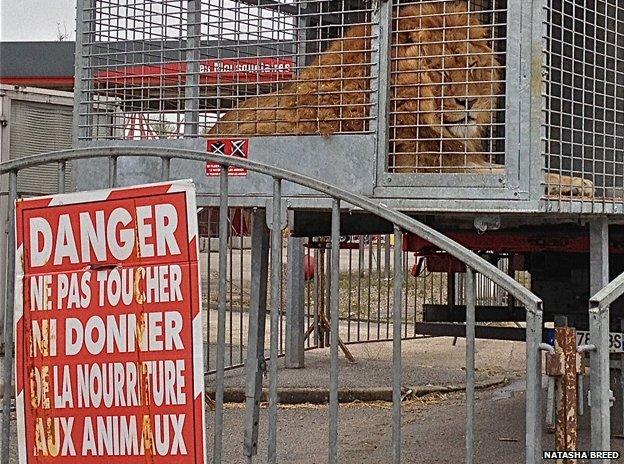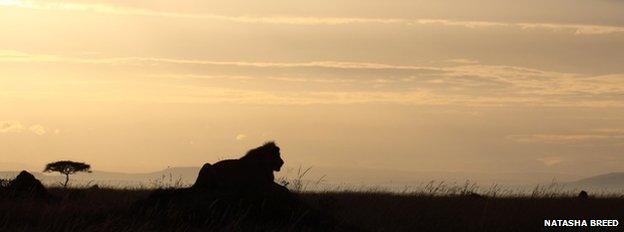The sad life of a circus lion
- Published

The circus continues to roll into various towns in Britain at this time of year, but increasingly it does so without the lions and tigers which were once synonymous with it. In some parts of Europe however, the days of performing animals are not over.
At the southern tip of Normandy lies the Parc Naturel du Perche. A picturesque patchwork of French countryside, seamed by winding streams and ramblers' footpaths, quilted with extensive forests and dotted with farms and orchards. Known for its tall Norman barns, local cider, and the sturdy Percheron draught horses used to pull heavy loads, it is a bucolic setting very different from the savannahs of Kenya that I am used to.
Yet here I am, in the middle of the Perche, and less than 10m away is an adult lion. He's about four years old, with a thick blond mane and a nose that is still a youthful pale pink. And he is lying like a sphinx, with his head up, looking at me.
How many times have I seen a lion lie like this before, in the shade of a tree gazing out lazily over the plains? Or, waiting expectantly as a lioness approaches to rub faces with him, in that wonderful tactile way lions greet each other? Or, closing his eyes in paternal indulgence, while his small cubs clamber over his hindquarters and pounce on the tassel of his tail, as his upper lip twitches into a gentle sneer?

I have spent years working with wildlife film crews following lions in Africa, and I have learned to read the big cats' moods in their eyes. Meeting the gaze of a lion, I have experienced that stomach-lurching intuition that tells me if I make one wrong move I am toast.
The pupils dilate, and the gaze becomes 100% focused - and suddenly I have felt what it might be like to be a wildebeest coming face to face with his nemesis.
But this lion's eyes barely flicker as I approach him. There is no gleam of interest, no unwavering intent, no spark of fun. Usually, for any cat, a moving target is always going to be fun to chase - whether it ends in a meal or not.
He is not even wary of me, as any self-respecting lion in Africa has learned to be, when a human approaches on foot. This animal is weary, dispirited, and - something I have never seen before - he is bored.
I had been driving to the local market town when I noticed the circus. Across a busy road, a McDonald's, a car wash and a DIY centre face a sprawling disused supermarket allotment. But today, a huge candy-striped Big Top, and a semi-circle of trailers are ranged around the car park of the abandoned store.

Some of the trailers have barred sides and I glimpse the familiar form of a lion standing in one of the cages. Then I notice the roadside posters - on street lamps, bus shelters and litterbins.
Beneath the headline Visit the Zoo, white tigers and lions leap through rings of fire, or pose majestically for their portraits. I read that the circus will be in town for five days. I park, cross the road and approach the circus.
A man is uncoupling a trailer from a truck and I ask if I can walk around. Squinting at me through a curl of blue smoke from the cigarette clamped between his lips, he nods.
Four shaggy Bactrian camels stand in a roped-off area of tarmac. No grass, no trees. Just white lines where shoppers once parked and a single lamp-post casting a narrow shadow - below which, pitiably, the camels have congregated.
Beyond is another trailer with more lions and tigers in it - yes, there are white ones there. The 2m by 12m carriage, partitioned into stalls, holds at least six big cats. Some sleep, others sit or stand up, staring out at passing traffic and pedestrians, with dull eyes.
The UK government recently announced that a ban prohibiting the use of wild animals in circuses in Britain would come into effect in 2015.
How many big cats, elephants and other animals watch the world through the bars of cages, without ever having known the infinity of wilderness? Knowing, instead, the blurred scenery of tarred roads, as they travel in gaudy procession from town to town.
The frightening, flickering flames of fire as they leap, night after night, through burning rings, or dance or perform headstands, to the crack of whips and the clamour of applause.
The tedium of their dreadful prisons. And the hopeless monotony of interminable exile.
How to listen to From Our Own Correspondent, external:
BBC Radio 4: Saturdays at 11:30 and some Thursdays at 11:00
Listen online or download the podcast.
BBC World Service: Short editions Monday-Friday - see World Service programme schedule.
You can follow the Magazine on Twitter, external and on Facebook, external